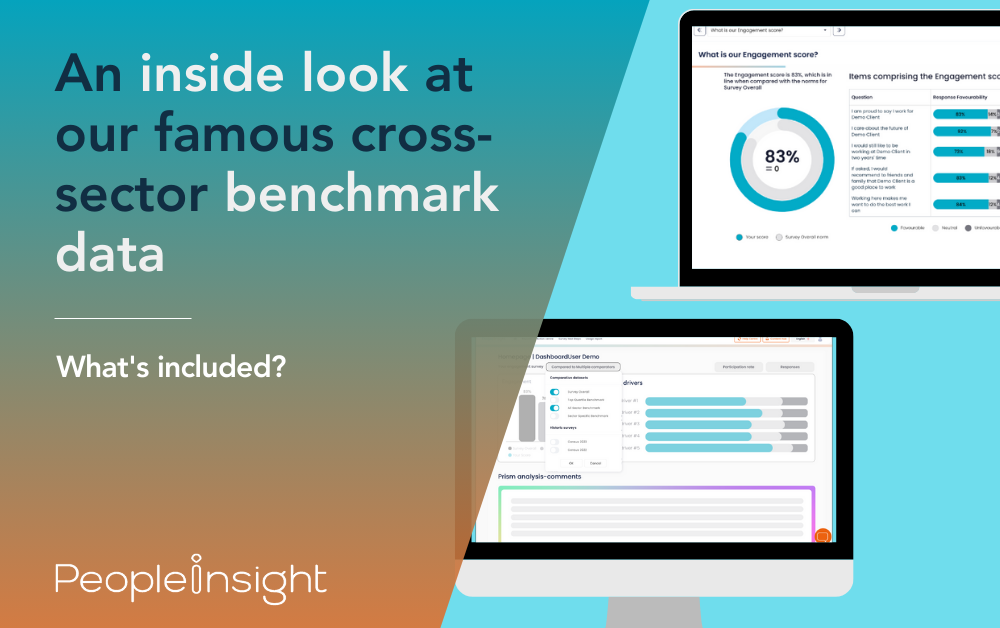
Benchmark data is one of the most powerful tools a company can use to understand how its company culture and employee experience compares to competitors. It gives you some pretty incredible (not to mention useful) insights into where you excel and where there’s room for improvement. At People Insight, we work across a wide range of industries, offering precise comparisons tailored to your sector, company size and workforce demographics.
Prospective clients often ask us: Who do you work with in our sector? How well do you really understand our industry? Do you have benchmark data for us to compare against? We know how important these questions are, which is why we wanted to create a guide dedicated to our famous benchmark data, discussing what you can do with it and how it can help take your company from strength to strength.
Below, we’ll explore some of the key comparisons you can draw using our benchmark data — but this is just a glimpse of what’s available. There’s far more to uncover in a full employee survey, helping you make informed decisions that drive long-term success.
Related: 10 AI prompts to get the most out of your employee surveys
One of the most common uses of benchmark data is to compare engagement levels across your industry. By measuring how your employees feel about leadership, benefits, training, development and company culture, you gain a clear picture of where you stand against competitors.
For example, if employees in your sector expect strong professional development opportunities but your company scores below the industry benchmark in this area, it could explain difficulties in attracting and retaining top talent. Benchmark data allows you to identify trends, set realistic goals and ultimately establish yourself as an employer of choice.
Understanding how different demographics experience the workplace is essential, and gender-based benchmarking is one of the most insightful ways to do this.
By comparing engagement scores across gender groups, you can identify disparities in areas such as career progression, flexibility, leadership support and workplace inclusion.
For example, our data shows that women are praised more often for their hard work (61%) than men (57%). They are also much happier, on average, with the benefits provided by their company (64%) than men (54%). However, they do feel generally that senior leaders don’t make a concerted effort to listen to staff at their organisation (60% vs 62%).
Workplace experiences can vary significantly between generations. While younger employees may prioritise career development and learning opportunities, older employees may place more value on job stability and leadership transparency.
By analysing benchmark data across age groups, companies can tailor policies to improve engagement for different generations. For instance, if your data shows that younger employees rate career progression poorly compared to sector benchmarks, it might be time to review your approach to training, mentorship and promotions.
Related: Age diversity: Building stronger teams across generations
Ethnicity and race-based benchmark data can help businesses understand whether employees from different backgrounds have equal access to opportunities, support and career development.
It’s worth noting that organisations that actively measure and improve inclusivity tend to see higher engagement and retention and ethnically diverse workplaces are more innovative and financially successful. By comparing your internal engagement scores to sector-wide benchmarks, you can uncover whether disparities exist in areas such as representation in leadership, access to training or overall workplace experience.
Leaders and managers experience the workplace differently from entry-level employees. Benchmarking by seniority allows you to compare how different levels of the organisation perceive leadership, communication and company direction.
For instance, if your leadership team scores highly on engagement but entry-level employees consistently rate leadership effectiveness below the sector average, there may be a disconnect in communication. These insights allow companies to refine leadership strategies, build stronger relationships and drive engagement at every level.
Employee experience isn’t just influenced by company-wide policies — it’s shaped by departmental culture, too. Some teams may report high engagement levels, while others struggle with communication or workload issues.
Benchmarking data by team helps identify which departments are thriving and which need more support. For example, if your customer service team consistently reports higher stress levels than other departments, you might compare these results against sector benchmarks to determine whether this is a company-specific issue or a wider industry challenge.
External comparisons are valuable, but tracking progress within your own company is just as important. Historical benchmark data allows you to measure how engagement has changed over time, revealing trends in employee experience and organisational culture.
If your engagement score for leadership has improved over the last three years, but work-life balance has declined, this could indicate the need for targeted initiatives. Benchmarking against your own company ensures that employee listening strategies translate into meaningful improvements.
When organisations commit to improving workplace culture, everyone reaps the rewards. Employees who feel engaged and valued are more likely to stay motivated, go that extra mile every day and do their bit to drive company success.
Companies that prioritise ongoing benchmarking and employee listening will always have an advantage, staying ahead of challenges before they become obstacles.
Benchmark data is only as useful as the insights you gain from it. Our employee surveys provide detailed benchmarking tailored to your sector, workforce and organisational goals. If you’re ready to understand where your company stands — and how you can improve — get in touch with us today.

